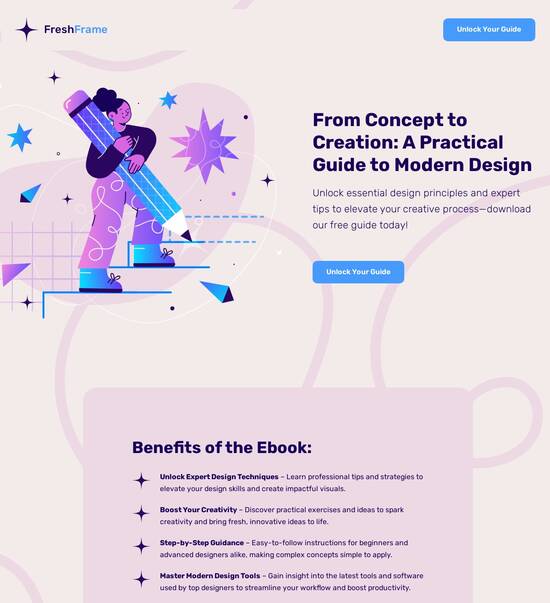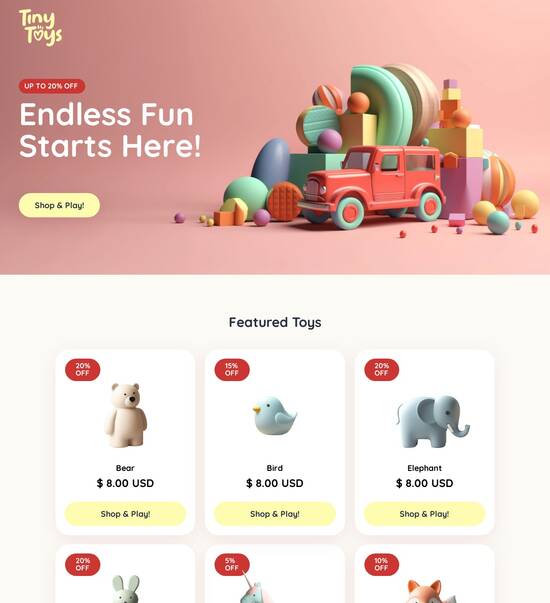
Laravel optimized portfolio website template
Explore Similar TemplatesAbout template
Leverage our intuitive page builder and high-converting Laravel optimized portfolio website template.
Recommended templates

Easy to build without coding
With the intuitive drag-and-drop builder, anyone on your team can create high-converting pages without any knowledge of code or design. Make enhancements to your landing page with custom widgets using Javascript, HTML/CSS, or third-party scripts.

Multiple layouts for any industry and goal
Select from 500+ landing page layouts built to boost conversions across industry-specific scenarios. Customize them by adjusting fonts, adding images, and generating on-brand content with the AI assistant. Quickly scale with Instablocks® and Global Blocks that you can save, reuse, and update globally.

Loads fast and looks polished on any device
Every template is responsive, which means they present professionally on any device and load blazingly fast with our Thor Render Engine. You can also power them up with Google AMP technology to deliver an unparalleled mobile experience and drive higher conversions.

Robust analytics & experimentation
Get real-time updates and reporting across all your devices, showing the number of visitors, conversions, cost-per-visitor, and cost-per-lead. Launch AI-powered experiments, run A/B tests, and use heatmaps to analyze user behavior, then optimize your landing page to maximize conversions.







Easy to build without coding
With the intuitive drag-and-drop builder, anyone on your team can create high-converting pages without any knowledge of code or design. Make enhancements to your landing page with custom widgets using Javascript, HTML/CSS, or third-party scripts.
Multiple layouts for any industry and goal
Select from 500+ landing page layouts built to boost conversions across industry-specific scenarios. Customize them by adjusting fonts, adding images, and generating on-brand content with the AI assistant. Quickly scale with Instablocks® and Global Blocks that you can save, reuse, and update globally.
Loads fast and looks polished on any device
Every template is responsive, which means they present professionally on any device and load blazingly fast with our Thor Render Engine.
Robust analytics & experimentation
Get real-time updates and reporting across all your devices, showing the number of visitors, conversions, cost-per-visitor, and cost-per-lead. Launch AI-powered experiments, run A/B tests, and use heatmaps to analyze user behavior, then optimize your landing page to maximize conversions.
All the features you need to build lead-generating landing pages
Explore more featuresLearn how to build top-performing landing pages for any goal
FAQs
Leading the way in building high-performing landing pages





A comprehensive guide to optimizing your digital marketing campaigns with Instapage
In the competitive landscape of digital marketing, optimizing your campaigns is crucial. Instapage offers a powerful landing page and conversion rate optimization (CRO) platform designed for marketers across various sectors including business services, tech, education, and financial services in the USA. This guide will take you through the essential steps to maximize your ROI using Instapage's unique features.
Understanding the core features of Instapage
Instapage offers a plethora of features that make it a preferred choice for marketers. Its extensive library of over 100 high-converting templates and intuitive lead generation elements streamlines the page creation process, allowing marketers to kick-start campaigns quickly and effectively. This section provides a brief overview of these features.
- Ready-to-use templates: Access a wide range of pre-built designs tailored for various industries to boost conversions.
- Drag-and-drop editor: Easily modify templates without needing coding knowledge, making customization straightforward.
- Lead gen elements: Utilize forms and CTA buttons that are designed to improve lead capture and conversion rates.
Step 1: Creating high-performing landing pages
The initial step in leveraging Instapage is building effective landing pages. This process can be simplified using their user-friendly tools. Here’s how to get started:
- Choose a template: Select from the library of conversion-focused layouts.
- Customize your content: Use the drag-and-drop editor to add text, images, and lead generation forms relevant to your audience.
- Utilize Instablocks: Save and reuse sections of content across pages, ensuring consistency and quick edits.
Step 2: Optimizing your pages for better results
Once your landing page is created, optimization is key. Instapage's built-in tools allow you to enhance performance effectively.
- A/B testing: Run experiments with different page variations to determine which elements generate higher conversions.
- Heatmaps: Analyze user behavior on the page to see where visitors click and scroll.
- Analytics dashboard: Use data insights to track performance metrics and make informed adjustments.
Step 3: Personalizing user experience
Personalization can significantly improve campaign response. Instapage provides tools to help marketers create tailored content that resonates with specific audience segments.
- Dynamic text replacement: Automatically change headlines based on visitor sources for alignment with ads.
- AdMaps: Match specific ads to targeted landing pages, ensuring relevance to your audience.
- Audience-level metric tracking: Gain insights on how different segments engage with your content.
By following these steps, you can fully leverage the capabilities of Instapage to optimize your digital marketing campaigns. Each feature is designed to enhance your strategies and improve ROI across various sectors.
Ready to elevate your marketing campaigns? Start exploring the power of Instapage today and witness the transformation in your digital strategies.
Laravel optimized portfolio website template
Understanding the Laravel framework
Laravel is a powerful PHP framework designed for building robust applications efficiently. It operates on the Model-View-Controller (MVC) architecture, which separates an application into three interconnected components. This division enhances code organization and support for multiple developers working on a project simultaneously. By keeping the business logic, data, and user interface decoupled, developers can enhance their workflow and maintain applications more easily.
Using Laravel for web development brings numerous advantages. First, its robust security features safeguard web applications against common vulnerabilities such as SQL injection and cross-site scripting. Second, Laravel’s routing capabilities allow seamless creation of customizable routes that enhance the user experience. Finally, the Blade templating engine enables effective interaction with HTML, empowering developers to create complex layouts with relative ease. Combined with compatibility for modern development practices, Laravel stands out as an ideal choice for developers.
The importance of portfolio websites for developers
For developers, portfolio websites serve as essential tools for professional branding. A well-designed portfolio showcases skills, expertise, and successful projects, helping to establish credibility in the industry. It can serve as a digital resume that prospective employers or clients can explore at any time, thus greatly enhancing visibility and professional opportunities.
Additionally, a thoughtfully structured portfolio enables effective project demonstration, allowing developers to highlight their best work. This presentation can include case studies, client testimonials, and project timelines that tell a compelling story. With the prevalence of mobile devices, incorporating responsive design is key to ensuring user engagement across different platforms, as a significant portion of users may access these websites on smartphones or tablets.
Key features of a Laravel optimized portfolio template
Laravel optimized portfolio website templates come packed with features that enhance their usability and performance. A notable aspect is their modular architecture. This component-based design approach allows developers to create, manage, and scale various sections independently. This modularity not only simplifies maintenance but also facilitates the addition of new functionalities, making it easier to adapt as the developer's portfolio expands.
Moreover, these templates are designed with responsive layouts in mind. Such adaptive designs ensure optimal viewing experiences across diverse devices. User experience considerations dictate that navigation should remain intuitive, whether the visitor is on a desktop, tablet, or smartphone. A seamless experience can significantly boost user engagement and retention, leading to higher conversion rates.
Modular architecture facilitates scalability and maintenance.
Responsive design caters to multi-device compatibility.
Built-in security features protect user data and application integrity.
Essential components and plugins for enhanced functionality
One of the vital components of a Laravel portfolio template is user authentication and authorization. Using packages like Laravel Breeze or Jetstream, developers can implement secure authentication systems that help manage user access. This ensures that sensitive data is protected, while also allowing for customizable user roles that can control the visibility of certain projects or sections.
Dynamic content management is also a cornerstone of Laravel's capabilities. Through Eloquent ORM, developers can interact effortlessly with databases, allowing for easy updates and management of portfolio content. Additionally, using plugins simplifies portfolio management by enabling drag-and-drop functionality, making it easier for developers to present their work dynamically.
User authentication using Laravel Breeze or Jetstream.
Dynamic content management with Eloquent ORM.
SEO optimization tools to improve site's search engine ranking.
Designing engaging user interfaces with Laravel
Designing user interfaces with Laravel allows developers to create visually appealing and functional websites. Customizable UI components can be built with front-end frameworks like Tailwind CSS or Bootstrap, known for their responsive design capabilities. These frameworks enable developers to apply aesthetic consistency across all pages while implementing intuitive navigation that enhances usability.
To effectively showcase projects, developers should adopt best practices for displaying project case studies. Techniques such as image sliders, galleries, and video embeds can promote interactive engagement. Such features draw visitors in and provide dynamic content that keeps users interested, potentially leading to better feedback and higher conversion rates.
Performance optimization techniques
Performance optimization is crucial for delivering a smooth user experience. One effective strategy is implementing Laravel’s built-in caching mechanisms. By caching frequently accessed data, applications can enhance load speeds significantly, leading to quicker page responses. This efficiency not only benefits user experience but also contributes positively to search engine rankings.
Writing clean and maintainable code ensures that projects remain manageable as they grow. Developers should leverage Laravel's extensive documentation to adopt best practices, which can facilitate easier updates and troubleshooting. Prioritizing code quality is essential, particularly in larger projects where maintainability can become complex.
The integration of third-party applications and APIs
Integrating third-party applications and APIs can greatly enhance the functionality of a Laravel portfolio website. For instance, developers can connect their sites with social media APIs to display their latest achievements or integrate analytics tools to track visitor engagement. Such integrations can add layers of rich content and improve the overall user experience.
Utilizing popular Laravel packages further extends the framework’s capabilities. Packages like Spatie's media library or Laravel Debugbar can streamline image management and boost performance monitoring, respectively. These tools can facilitate efficient project management, making it easier to keep the portfolio up-to-date with the developer's latest work.
Examples of API integrations for social media or analytics.
Utilizing Laravel packages to extend functionality.
Enhancing project management and display with plugins.
Case studies: Successful Laravel portfolio websites
Highlighting successful Laravel-based portfolio websites gives valuable insight into effective design and functionality. Notable examples demonstrate how unique applications of the framework can lead to aesthetically pleasing and highly functional portfolios. These websites often showcase key features like smooth navigation, rich media integration, and responsive layouts, all contributing to their overall effectiveness.
User feedback can also provide insight into the effectiveness of these portfolio templates. Testimonials from developers who have utilized these templates often emphasize the importance of design adaptability and their portfolios' ease of use. Analyzing user engagement metrics and conversion rates can reveal the impact of a well-structured site on attracting clients and employers.
Building your own Laravel portfolio template
Developing your own Laravel portfolio template begins by setting up the Laravel environment. Start by installing Laravel via Composer and configuring the necessary environment files. This attention to foundational setup is critical for ensuring a smooth development process.
Once set up, leveraging version control systems like Git can aid in managing your project effectively. Regular commits and branch management not only provide a safety net but also enhance collaboration if working in a team. Following this, practical project implementation strategies, such as designing interactive layouts with Laravel components, will create a more engaging user experience.
Enhancing security and compliance measures
Security is paramount in web development, particularly when handling user data. Understanding common security vulnerabilities such as cross-site scripting and SQL injection is essential. Implementing security measures like Laravel's CSRF protection, sanitization techniques, and regular updates protects portfolios from potential threats.
Compliance with data regulations, such as GDPR, is also crucial. Developers must design their applications to respect user privacy and data handling. Tools and practices, like data encryption and clear user consent protocols, can ensure that portfolio websites align with legal requirements while fostering trust with users.
Future trends in portfolio website development
The landscape of portfolio website development continues to evolve as emerging technologies pave the way for innovative designs. Predictions include the integration of critical technologies such as augmented reality, which can offer immersive project displays. Developers should stay informed about these trends to maintain their portfolios' relevance and attract more viewers.
The role of AI and machine learning is increasingly significant as well. These technologies can personalize user experiences, making content recommendations more relevant and engaging. By leveraging ML algorithms, developers can analyze user behavior patterns to curate content that resonates with the audience.
Comprehensive documentation and learning resources
Navigating Laravel's documentation is vital for developers aiming to utilize its full potential. Effective documentation provides a roadmap for troubleshooting and upgrading functionalities. Beyond official Laravel documents, exploring community-driven resources, forums, and tutorials can provide supplementary insights that enhance development skills.
Building a community around Laravel development plays an equally crucial role in professional growth. Engaging in discussions, attending meetups, and participating in online courses not only enrich knowledge but also foster collaboration among developers. This shared knowledge can contribute significantly to overall project quality and innovation.
Ready to skyrocket conversions?
Supercharge your ad campaigns with high-performing landing pages
Get started














